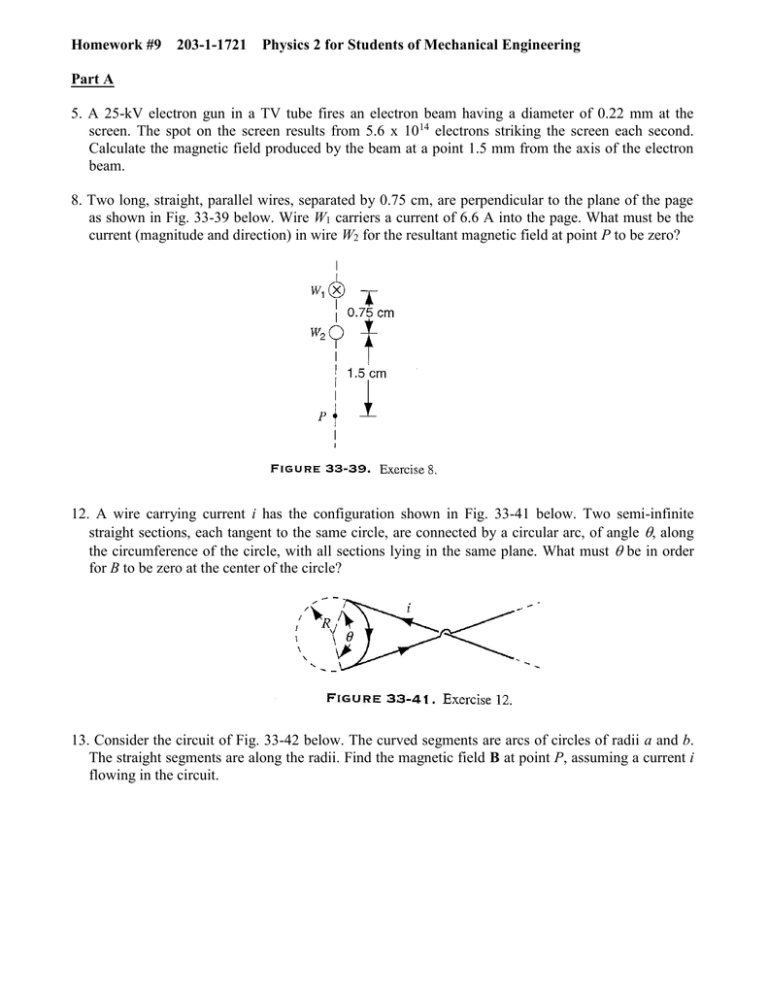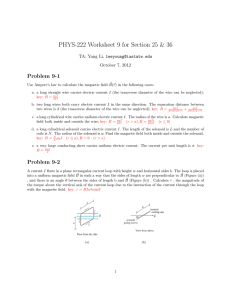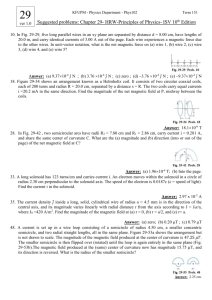Homework #9 203-1-1721 Physics... Part A
advertisement

Homework #9 203-1-1721 Physics 2 for Students of Mechanical Engineering Part A 5. A 25-kV electron gun in a TV tube fires an electron beam having a diameter of 0.22 mm at the screen. The spot on the screen results from 5.6 x 1014 electrons striking the screen each second. Calculate the magnetic field produced by the beam at a point 1.5 mm from the axis of the electron beam. 8. Two long, straight, parallel wires, separated by 0.75 cm, are perpendicular to the plane of the page as shown in Fig. 33-39 below. Wire W1 carriers a current of 6.6 A into the page. What must be the current (magnitude and direction) in wire W2 for the resultant magnetic field at point P to be zero? 12. A wire carrying current i has the configuration shown in Fig. 33-41 below. Two semi-infinite straight sections, each tangent to the same circle, are connected by a circular arc, of angle , along the circumference of the circle, with all sections lying in the same plane. What must be in order for B to be zero at the center of the circle? 13. Consider the circuit of Fig. 33-42 below. The curved segments are arcs of circles of radii a and b. The straight segments are along the radii. Find the magnetic field B at point P, assuming a current i flowing in the circuit. 18. Two long wires a distance b apart carry equal anti-parallel currents i, as shown in Fig. 33-45 below. (a) Show that the magnetic field strength at point P, which is equidistant from the wires, is given by B = (2 0 ib)/(4R2 + b2). (b) In which direction does B point? 21. Four long copper wires are parallel to each other and arranged in a square, as shown in Fig. 33-47 below. The wires carry equal currents i out of the page, as shown. Calculate the force per meter on any one wire and give its magnitude and direction. Assume that i = 18.7 A and a = 24.5 cm. (This is known as the Pinch Effect in the case of parallel motion of charged particles in a plasma.) 24. Figure 33-50 below shows a long wire carrying a current i1. The rectangular loop carries a current i2. Calculate the resultant force acting on the loop. Assume that a = 1.10 cm, b = 9.20 cm, L = 32.3 cm, i1 = 28.6 A, and i2 = 21.8 A. 26. A solenoid with a length of 95.6 cm has a radius of 1.90 cm, a winding of 1230 turns, and carries a current of 3.58 A. Calculate the strength of the magnetic field inside the solenoid. 27. A solenoid 1.33 m long and 2.60 cm in diameter carriers a current of 17.8 A. The magnetic field inside the solenoid is 22.4 mT. Find the length of the wire forming the solenoid. 31. Each of the indicated eight conductors in Fig. 33-52 below carries 2.0 A of current into or out of the page. Two paths are indicated for the line integral Bds. What is the value of the integral for (a) the dotted path and (b) the dashed path? 33. Figure 33-53 below shows a cross-section of a long conductor of a type called a coaxial cable of radii a, b, and c. Equal but anti-parallel, uniformly distributed currents i exist in the two conductors. Derive expressions for B(r) in the ranges (a) r < c, (b) c < r < b, (c) b < r < a, and (d) r > a. (e) Test these expressions for all the special cases that occur to you. (f) Assume that a = 2.0 cm, b = 1.8 cm, c = 0.40 cm, and i = 120 A and plot B(r) over the range 0 < r < 3 cm. 34. Figure 33-54 below shows a cross-section of a hollow, cylindrical conductor of radii a and b, carrying a uniformly distributed current i. (a) Using the circular Amperian loop shown, verify that B(r) for the range b < r < a is given by B(r) = 0 i(r2 – b2)/[2r(a2- b2)]. (b) Test this formula for the special cases of r = a, r = b, and b = 0. (c) Assume that a = 2.0 cm, b = 1.8 cm, and i = 100 A and plot B(r) for the range 0 < r < 6 cm. 36. A toroid having a square cross-section, 5.20 cm on edge, and an inner radius of 16.2 cm has 535 turns and carries a current of 813 mA. Calculate the magnetic field inside the toroid at (a) the inner radius and (b) the outer radius of the toroid. Part B 1. Figure 33-57 below shows an arrangement known as a Helmholtz coil. It consists of two circular coaxial coils each possessing N turns and radius R, separated by a distance R. The coils carry equal currents i in the same direction. Find the magnetic field at the point P, midway between the coils. 2. A straight section of wire of length L carries a current i. (a) Show that the magnetic field associated with this segment alone at point P, a perpendicular distance D from one end of the wire (as shown in Fig. 33-58 below), is given by B = 0 iL/[4D(L2 + D2)1/2]. 4. A square loop of wire of edge a carries a current i. (a) Show that B for a point on the axis of the loop and a distance z from its center is given by B(z) = 40 ia2/[(4z2 + a2)(4z2 + 2a2)1/2]. (b) To what does this reduce at the center of the loop? 7. (a) Calculate B at point P in Fig. 33-59 below. (b) Is the field strength at point P greater or less than at the center of the square? 8. A thin plastic disk of radius R has a charge q uniformly distributed over its surface. If the disk rotates at an angular frequency about its axis, show that the magnetic field at the center of the disk is B = (0 q)/(2 R). (Hint: The rotating disk is equivalent to an array of current loops.) 9. A long solenoid has 100 turns per centimeter. An electron moves within the solenoid in a circle of radius 2.30 cm perpendicular to the axis of the solenoid. The speed of the electron is 0.0460c (where c = 3 x 108 m/s, i.e. the speed of light.) Find the current in the solenoid.





